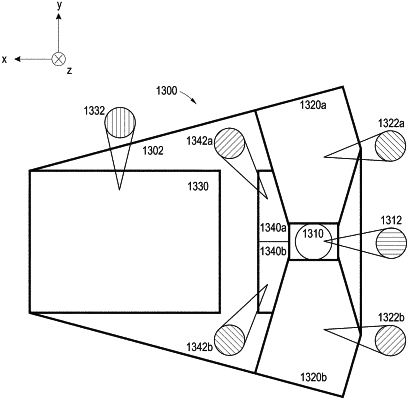| CPC G02B 6/122 (2013.01) [G02B 6/02085 (2013.01); G02B 27/0172 (2013.01); G06T 19/006 (2013.01); G02B 2027/0125 (2013.01)] | 22 Claims |

|
1. An eyepiece for a virtual reality, augmented reality, or mixed reality system, the eyepiece comprising:
a waveguide substrate that is at least partially transparent;
an input coupler grating formed on or in the waveguide substrate and configured to couple, divide, and redirect at least one input light beam that is externally incident on the input coupler grating into at least a first guide light beam and a second guided light beam that propagate inside the waveguide substrate;
a first orthogonal pupil expander (OPE) grating formed on or in the waveguide substrate and configured to divide the first guided light beam from the input coupler grating into a first plurality of parallel, spaced-apart light beams;
a second OPE grating formed on or in the waveguide substrate and configured to divide the second guided light beam from the input coupler grating into a second plurality of parallel, spaced-apart light beams;
a first spreader grating that receives at least some of the first plurality of parallel, spaced-apart light beams from the first OPE grating and spreads their distribution, the first spreader grating comprising diffractive features oriented at approximately 90° to diffractive features of the first OPE grating;
a second spreader grating configured to receive at least some of the second plurality of parallel, spaced-apart light beams from the second OPE grating; and
an exit pupil expander (EPE) grating formed on or in the waveguide substrate and configured to re-direct light beams from the first and second OPE gratings, and from the first and second spreader gratings, such that they exit the waveguide substrate,
wherein the first and second OPE gratings are slanted toward the EPE grating,
wherein the input coupler grating is positioned between the first OPE grating and the second OPE grating and is configured to direct the first guided light beam toward the first OPE grating and to direct the second guided light beam toward the second OPE grating,
wherein the first and second OPE gratings are separated by approximately 120° and the EPE grating is located at about 60° to both OPE gratings, and
wherein the second spreader grating is configured to spread the distribution of the at least some of the second plurality of parallel, spaced-apart light beams from the second OPE grating so as to reach a larger portion of the EPE grating.
|